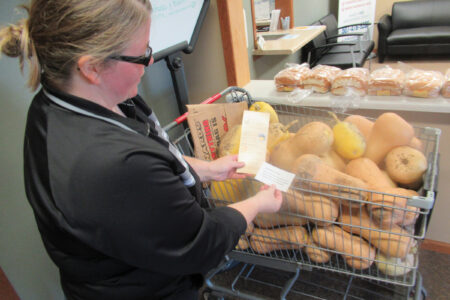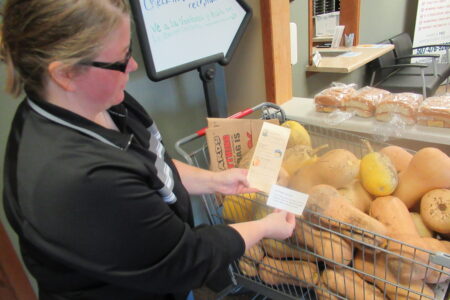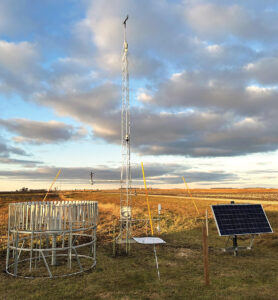All about agriculture
Area students get an education about life on the farm during Ag in the Classroom
GRANITE FALLS – More than 280 elementary students representing 10 area schools participated in the largest-ever Yellow Medicine County Ag in the Classroom event on Tuesday at Minnesota West Community and Technical College in Granite Falls.
The students – including those from the public schools of Canby, Minneota, Dawson-Boyd, Yellow Medicine East and Clarkfield Area Charter School in addition to homeschooled and parochial students from St. Peter Catholic, Samuel Lutheran and Marshall Area Christian School – rotated around to nine different stations throughout the day.
“It was really good,” Roger Dale said. “We had over 280 kids (Monday), which is the most kids we’ve ever had. And that doesn’t include the teachers, chaperones or the bus drivers.”
Dale and Carl Louwagie are the organizers of the event, but they’ll be the first to credit other volunteers for making the day such a success.
“We couldn’t do this without the help of a lot of good people,” Dale Louwagie said. “Liz DeBlieck from the Yellow Medicine East office does everything on the computer. She’s super. And we have terrific presenters. We had people here from Lyon County, Lac qui Parle County and Yellow Medicine County.”
While most of the presenters were adults, the beef session was handled entirely by high school students. Canby High school’s Rebecca Kallhoff and Tyler Goplen joined brothers Chase Olson and Tyson Olson (Dawson) and sisters Bailee Schiefelbein and Abbey Schiefelbein (Kimball) to educate the young students about beef.
“They’re speaking from the heart,” Dale said. “That goes a long ways.”
The beef presenters led the students through a matching game. In small teams, the students attempted to match the words – hamburger, roast, steak and jerky – to the actual product. Then, they were asked to match five beef cattle breeds – Charolais, Angus, Hereford, shorthorn and longhorn – to their corresponding photo. A group of two girls from MACS and a group of four girls from Samuel Lutheran were 100 percent correct and received coloring books as prizes.
Next, the youngsters learned about beef byproducts. Abbey Schiefelbein asked them a series of questions: “How many of you rode in a bus or drove in a car today? Tires contain a fatty acid that comes from beef,” she said. “How many of you guys brushed your teeth? There’s a fatty acid in beef that helps keep your teeth clean. How many of you guys have heard or played the piano? The piano keys actually come from beef bones.”
When asked how many basketballs they thought could be made from one cowhide, the students came up with answers of 110, 50, 35 and 10 before narrowing in on it.
“Twelve basketballs can be made from one cowhide,” Schiefelbein said.
Then, the students got to play an alternate version of bingo. The game of “Beefo” was named that because the items on the bingo-like card were all beef byproducts such as: marshmallows, cake mix, shaving cream, floor wax, cellophane, chewing gum, candles, basketballs, iron pills, deodorant and cosmetics.
Samuel Lutheran student Madeline Prahl was the first to cover five spaces in a row.
“It was good,” Prahl said. “I got a pencil.”
When asked what interesting things she learned, Prahl noted the fact about how many basketballs could be made from one cow (12).
YME fifth-grader Landon Anderson said he thought Ag in the Classroom “was pretty cool.”
“I liked everything about it,” Anderson said.
Anderson said he liked learning about turkeys and was surprised at how many presenters Jamie and Paul Kvistad had on their farm.
“We have about 80,000 turkeys on our farm,” Jamie Kvistad said. “That’s pretty much full for us.”
Students watched a turkey video and then learned interesting facts about the large bird.
“They eat corn and soybeans ground up,” Paul Kvistad said. “We also put minerals and vitamins in there. We order that from a feed mill.”
Kvistad also talked about how no hormones were added.
“It’s illegal,” he said.
Turkeys do need grit, though, to help them grind up their food.
“Turkeys have no teeth,” Kvistad said. “And they don’t have access to rocks, so I feed them grit. The grit helps grind up their food in their gizzard.”
The students also learned that Minnesota is the No. 1 turkey-producing state in the nation, totaling 46 million annually.
During the session, students got to see samples of feed, bedding and grit. Trivia winners received drawstring bags.
At the farm safety station, Dave Craigmile told the students that “safety is no accident.”
“It’s important to be aware,” he said.
Dave Berguson pointed out that statistically, farming was the most dangerous occupation.
“In 2013, 21 people died in farm accidents,” Berguson said. “And there were more than 1,000 injuries, too.”
A few students shared their knowledge about what specific accidents could occur on a farm. Their answers included: being run over by a combine, falling off a grain bin, falling into a grain bin, being caught in a grain auger and getting stuck in equipment.
The farm safety presenters, including the father and son duo of Gene and Rob Stengel, then displayed a variety of potentially dangerous behaviors. Celery and carrots were cut and shredded to pieces during the pinch point demonstration.
“All of a sudden those ‘fingers’ become little pieces,” Rob Stengel said. “So always leave the shield in place.”
Gene Stengel told about Richard Rosetter, who died in 2014, as the result of being sucked down into a grain bin.
“We lost track of him for a space of 12 minutes,” Stengel said. “In that time, he was sucked down 24 feet. The grain is like quicksand. Even with two emergency crews, it took over seven hours to get him out.”
Tragedies like Rosetter’s death are never forgotten, though it serves as a firm reminder about the importance of continued safety.
“Now we work in a buddy system,” Stengel said. “And you never turn your back on anyone.”
Rob Stengel noted that while it can be dangerous, farming is also a very necessary and enjoyable occupation.
“Farming is a way of life in rural Minnesota, and we need farmers to feed the world,” he said. “We just need everyone to practice safety at all times.”
Other stations included REC electricity, conservation, soybeans, corn, dairy and pork.
“It was fun,” YME student Wyatt Dambroten said. “I learned a lot. I learned about dairy, how the milking process goes.”
Canby student Zach Ourada was excited after lunch, knowing he had four more sessions left to attend.
“It’s been really fun,” Ourada said. “I learned about what stuff beef can make, as well as soybeans and corn. I didn’t know you can make corn and soybeans and beef into oil.”
Jerlyn Calderon, a Minneota fourth-grader, said she’d encourage other students to attend Ag in the Classroom.
“It’s really good,” she said. “I learned about safety. I learned about dairy cows. I didn’t know that the mother cows didn’t like their cubs (calves), so the farmer has to take care of them.”



